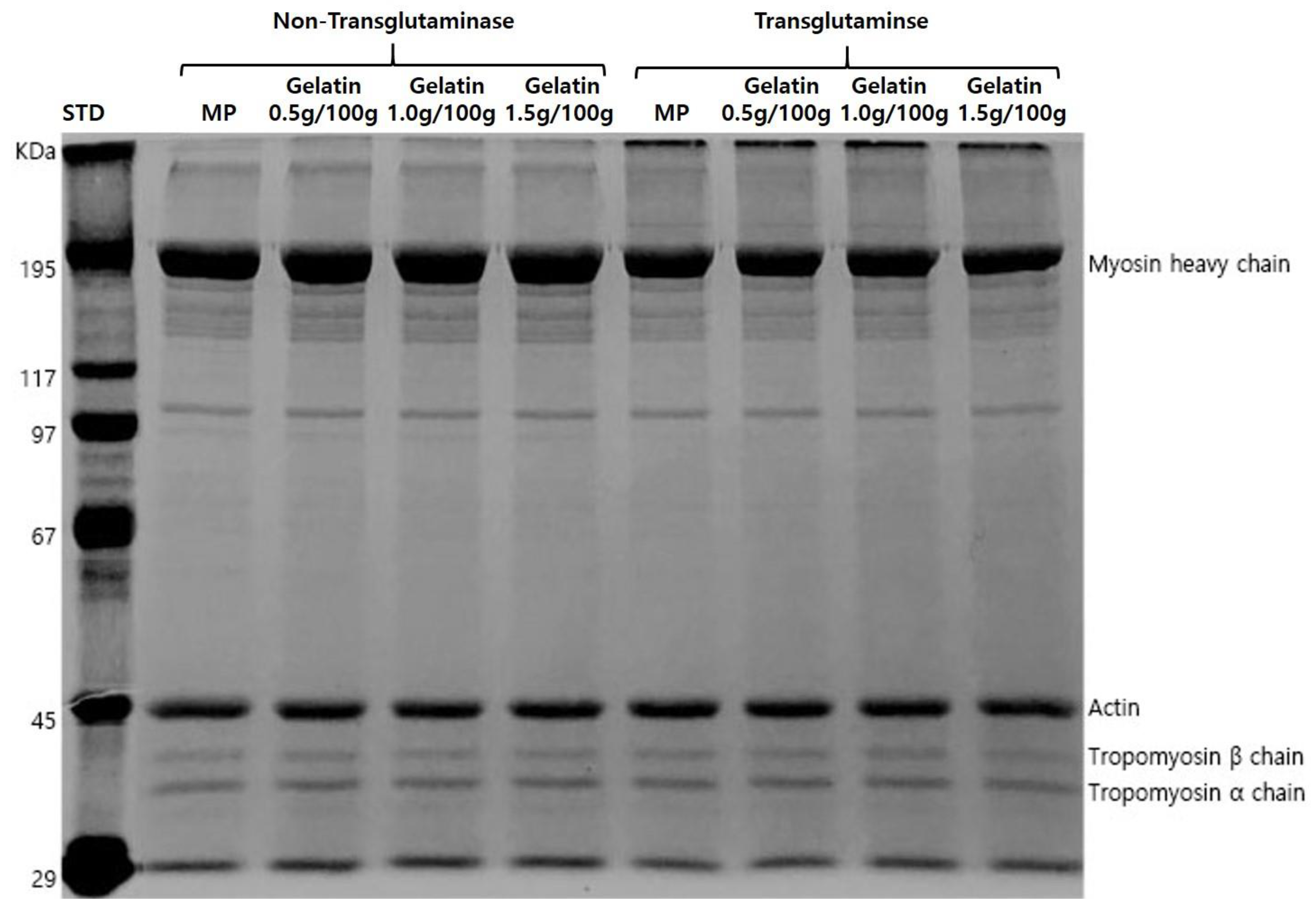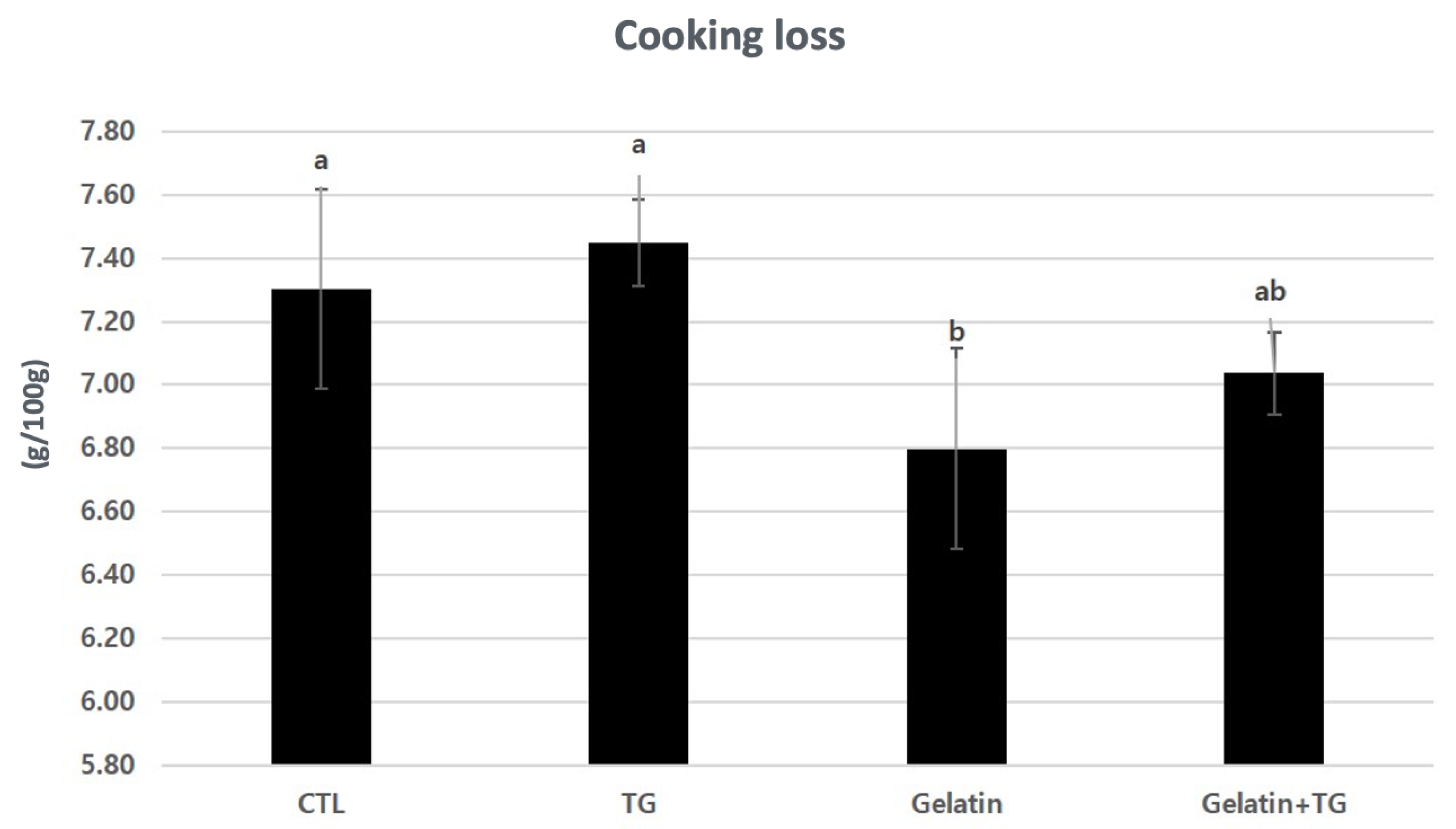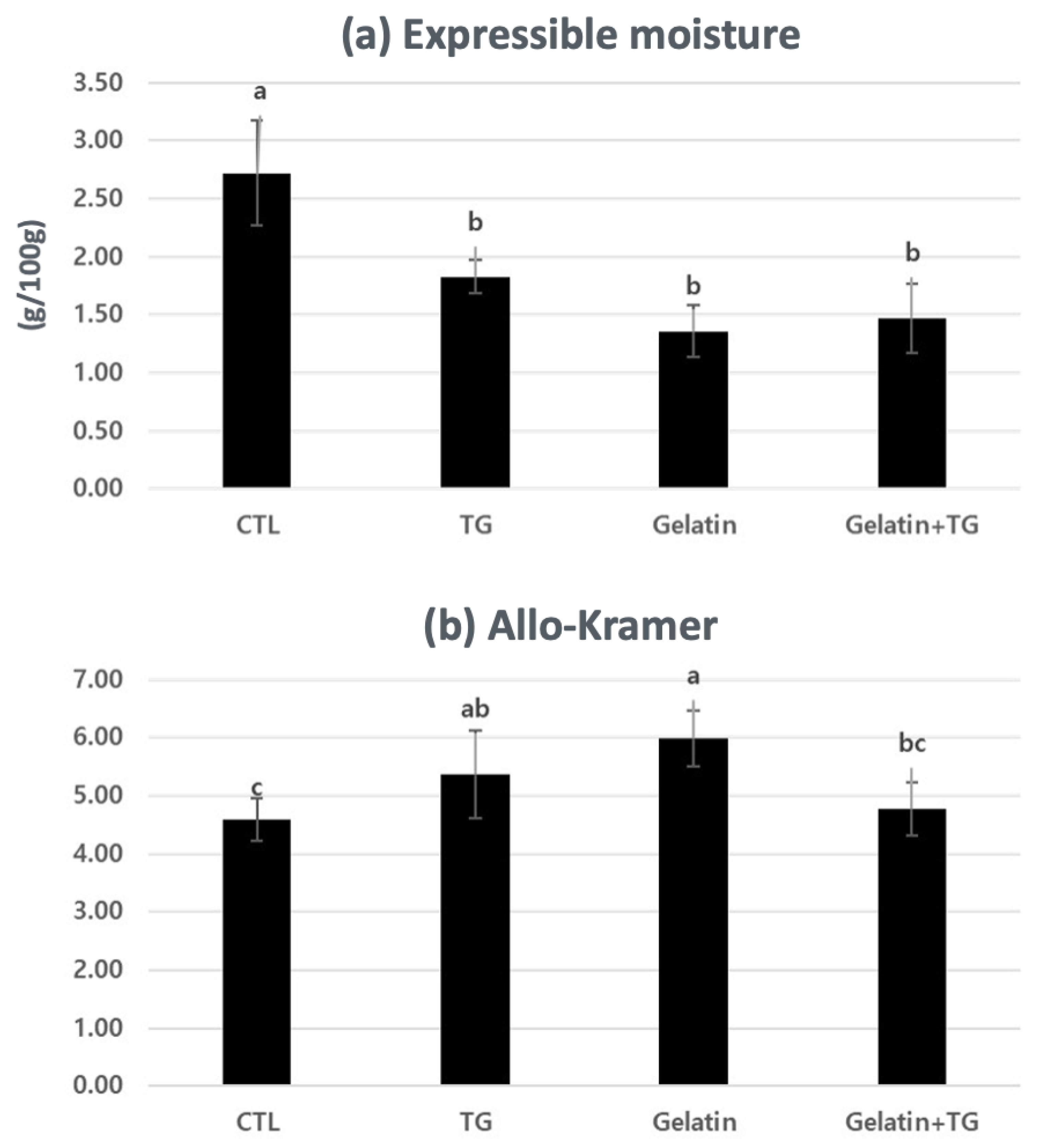Effect of Pork Skin Gelatin on the Physical Properties of Pork Myofibrillar Protein Gel and Restructured Ham with Microbial Transglutaminase
Abstract
:1. Introduction
2. Results and Discussion
2.1. Physical Properties of Myofibrillar Protein Gels
2.2. Physical Properties of Restructured Ham
3. Conclusions
4. Materials and Methods
4.1. Materials
4.2. Preparation of Myofibrillar Protein Gels with Gelatin and Transglutaminase
4.2.1. Cooking Loss and Gel Strength of Myofibrillar Protein Gels
4.2.2. The Viscosity of Myofibrillar Protein Mixtures
4.2.3. Sodium Dodecyl Sulfate-Polyacrylamide Gel Electrophoresis of Myofibrillar Protein Mixtures
4.2.4. Microstructure of Myofibrillar Protein Gels
4.3. Restructured Ham Processing Procedure
4.3.1. pH and Color Values of Restructured Ham
4.3.2. Cooking Loss and Expressible Moisture of Restructured Ham
4.3.3. Allo–Kramer Value of Restructured Ham
4.3.4. Fourier-Transform Infrared Spectroscopy (FTIR) of Restructured Ham
4.3.5. Protein Surface Hydrophobicity of Restructured Ham
4.3.6. Sulfhydryl Content of Restructured Ham
4.3.7. Sensory Evaluation of Restructured Ham
4.4. Statistical Analysis
Author Contributions
Funding
Institutional Review Board Statement
Informed Consent Statement
Data Availability Statement
Conflicts of Interest
References
- Lee, C.H.; Chin, K.B. Effects of pork gelatin levels on the physicochemical and textural properties of model sausages at different fat levels. LWT 2016, 74, 325–330. [Google Scholar] [CrossRef]
- Vergauwen, B.; Stevens, P.; Prawitt, J.; Olijve, J.; Brouns, E.; Babel, W.; Schulz, D.; Giesen-Wiese, M.; Seybold, U.; Gareis, H. Gelatin. In Ullmann’s Encyclopedia of Industrial Chemistry; Wiley-VCH: Hoboken, NJ, USA, 2000. [Google Scholar]
- Ahhmed, A.M.; Kuroda, R.; Kawahara, S.; Ohta, K.; Nakade, K.; Aoki, T.; Muguruma, M. Dependence of microbial transglutaminase on meat type in myofibrillar proteins cross-linking. Food Chem. 2009, 112, 354–361. [Google Scholar] [CrossRef]
- Kuraishi, C.; Yamazaki, K.; Susa, Y. Transglutaminase: Its utilization in the food industry. Food Rev. Int. 2001, 17, 221–246. [Google Scholar] [CrossRef]
- Santhi, D.; Kalaikannan, A.; Malairaj, P.; Arun Prabhu, S. Application of microbial transglutaminase in meat foods: A review. Crit. Rev. Food Sci. Nutr. 2017, 57, 2071–2076. [Google Scholar] [CrossRef] [PubMed]
- Jongjareonrak, A.; Benjakul, S.; Visessanguan, W.; Prodpran, T.; Tanaka, M. Characterization of edible films from skin gelatin of brownstripe red snapper and bigeye snapper. Food Hydrocoll. 2006, 20, 492–501. [Google Scholar] [CrossRef]
- Han, M.; Zhang, Y.; Fei, Y.; Xu, X.; Zhou, G. Effect of microbial transglutaminase on NMR relaxometry and microstructure of pork myofibrillar protein gel. Eur. Food Res. Technol. 2009, 228, 665–670. [Google Scholar] [CrossRef]
- Ramírez, J.; Uresti, R.; Téllez, S.; Vázquez, M. Using salt and microbial transglutaminase as binding agents in restructured fish products resembling hams. J. Food Sci. 2002, 67, 1778–1784. [Google Scholar] [CrossRef]
- Kuraishi, C.; Sakamoto, J.; Yamazaki, K.; Susa, Y.; Kuhara, C.; Soeda, T. Production of restructured meat using microbial transglutaminase without salt or cooking. J. Food Sci. 1997, 62, 488–490. [Google Scholar] [CrossRef]
- Jridi, M.; Abdelhedi, O.; Souissi, N.; Kammoun, M.; Nasri, M.; Ayadi, M.A. Improvement of the physicochemical, textural and sensory properties of meat sausage by edible cuttlefish gelatin addition. Food Biosci. 2015, 12, 67–72. [Google Scholar] [CrossRef]
- Feng, X.; Fu, C.; Yang, H. Gelatin addition improves the nutrient retention, texture and mass transfer of fish balls without altering their nanostructure during boiling. LWT 2017, 77, 142–151. [Google Scholar] [CrossRef]
- Stavinskaya, O.; Laguta, I.; Kuzema, P. Effect of highly dispersed silica on water absorption of gelatin materials. Prot. Met. Phys. Chem. Surf. 2011, 47, 302–306. [Google Scholar] [CrossRef]
- Yasin, H.; Babji, A.S.; Ismail, H. Optimization and rheological properties of chicken ball as affected by κ-carrageenan, fish gelatin and chicken meat. LWT 2016, 66, 79–85. [Google Scholar] [CrossRef]
- Norziah, M.; Al-Hassan, A.; Khairulnizam, A.; Mordi, M.; Norita, M. Characterization of fish gelatin from surimi processing wastes: Thermal analysis and effect of transglutaminase on gel properties. Food Hydrocoll. 2009, 23, 1610–1616. [Google Scholar] [CrossRef]
- Brodsky, B.; Persikov, A.V. Molecular structure of the collagen triple helix. Adv. Protein Chem. 2005, 70, 301–339. [Google Scholar]
- Pang, Z.; Deeth, H.; Sopade, P.; Sharma, R.; Bansal, N. Rheology, texture and microstructure of gelatin gels with and without milk proteins. Food Hydrocoll. 2014, 35, 484–493. [Google Scholar] [CrossRef]
- Brewer, M.; Peterson, W.; Carr, T.; Mccusker, R.; Novakofski, J. Thermal gelation properties of myofibrillar protein and gelatin combinations. J. Muscle Foods 2005, 16, 126–140. [Google Scholar] [CrossRef]
- Kaewudom, P.; Benjakul, S.; Kijroongrojana, K. Properties of surimi gel as influenced by fish gelatin and microbial transglutaminase. Food Biosci. 2013, 1, 39–47. [Google Scholar] [CrossRef]
- Cao, N.; Fu, Y.; He, J. Preparation and physical properties of soy protein isolate and gelatin composite films. Food Hydrocoll. 2007, 21, 1153–1162. [Google Scholar] [CrossRef]
- Sun, X.D.; Holley, R.A. Factors influencing gel formation by myofibrillar proteins in muscle foods. Compr. Rev. Food Sci. Food Saf. 2011, 10, 33–51. [Google Scholar] [CrossRef]
- Zhang, Z.; Yang, Y.; Tang, X.; Chen, Y.; You, Y. Chemical forces and water holding capacity study of heat-induced myofibrillar protein gel as affected by high pressure. Food Chem. 2015, 188, 111–118. [Google Scholar] [CrossRef]
- Li, C.; Xiong, Y.L.; Chen, J. Oxidation-induced unfolding facilitates myosin cross-linking in myofibrillar protein by microbial transglutaminase. J. Agric. Food Chem. 2012, 60, 8020–8027. [Google Scholar] [CrossRef] [PubMed]
- Hafidz, R.; Yaakob, C.; Amin, I.; Noorfaizan, A. Chemical and functional properties of bovine and porcine skin gelatin. Int. Food Res. J. 2011, 18, 813–817. [Google Scholar]
- Sow, L.C.; Yang, H. Effects of salt and sugar addition on the physicochemical properties and nanostructure of fish gelatin. Food Hydrocoll. 2015, 45, 72–82. [Google Scholar] [CrossRef]
- Tseng, T.-F.; Liu, D.-C.; Chen, M.-T. Evaluation of transglutaminase on the quality of low-salt chicken meat-balls. Meat Sci. 2000, 55, 427–431. [Google Scholar] [CrossRef] [PubMed]
- Gaspar, A.L.C.; de Góes-Favoni, S.P. Action of microbial transglutaminase (MTGase) in the modification of food proteins: A review. Food Chem. 2015, 171, 315–322. [Google Scholar] [CrossRef]
- Guerrero, P.; Kerry, J.P.; de la Caba, K. FTIR characterization of protein–polysaccharide interactions in extruded blends. Carbohydr. Polym. 2014, 111, 598–605. [Google Scholar] [CrossRef]
- Li, C.; Xiong, Y.L. Disruption of secondary structure by oxidative stress alters the cross-linking pattern of myosin by microbial transglutaminase. Meat Sci. 2015, 108, 97–105. [Google Scholar] [CrossRef]
- Herrero, A.M.; Cambero, M.; Ordóñez, J.; De la Hoz, L.; Carmona, P. Raman spectroscopy study of the structural effect of microbial transglutaminase on meat systems and its relationship with textural characteristics. Food Chem. 2008, 109, 25–32. [Google Scholar] [CrossRef] [Green Version]
- Sun, W.; Zhou, F.; Zhao, M.; Yang, B.; Cui, C. Physicochemical changes of myofibrillar proteins during processing of Cantonese sausage in relation to their aggregation behaviour and in vitro digestibility. Food Chem. 2011, 129, 472–478. [Google Scholar] [CrossRef]
- Bulaj, G. Formation of disulfide bonds in proteins and peptides. Biotechnol. Adv. 2005, 23, 87–92. [Google Scholar] [CrossRef]
- Laemmli, U.K. Cleavage of structural proteins during the assembly of the head of bacteriophage T4. Nature 1970, 227, 680–685. [Google Scholar] [CrossRef]
- Jauregui, C.; Regenstein, J.; Baker, R. A simple centrifugal method for measuring expressible moisture, a water-binding property of muscle foods. J. Food Sci. 1981, 46, 1271. [Google Scholar] [CrossRef]
- Chelh, I.; Gatellier, P.; Santé-Lhoutellier, V. A simplified procedure for myofibril hydrophobicity determination. Meat Sci. 2006, 74, 681–683. [Google Scholar] [CrossRef]







| TGase * | Gelatin Concentrations (g/100 g) | ||||||
|---|---|---|---|---|---|---|---|
| NTG | TG | 0 | 0.50 | 1.00 | 1.50 | ||
| Cooking loss (g/100 g) | Mean | 9.30 b | 13.1 a | 18.1 a | 12.2 b | 8.56 b,c | 5.25 c |
| S.D. | 5.78 | 6.67 | 5.42 | 5.32 | 3.66 | 2.40 | |
| Gel strength (gf) | Mean | 88.7 b | 157 a | 111 | 107 | 130 | 144 |
| S.D. | 38.9 | 58.7 | 60.4 | 51.9 | 69.4 | 65.4 | |
| Treatments * | |||||
|---|---|---|---|---|---|
| CTL | TG | Gelatin | Gelatin + TG | ||
| pH | Mean | 6.07 | 5.99 | 5.98 | 5.95 |
| S.D. | 0.06 | 0.11 | 0.02 | 0.09 | |
| CIE L* | Mean | 64.3 | 64.3 | 64.3 | 65.7 |
| S.D. | 0.25 | 2.10 | 1.59 | 0.21 | |
| CIE a* | Mean | 11.7 | 11.0 | 11.2 | 10.3 |
| S.D. | 0.40 | 0.73 | 0.33 | 1.01 | |
| CIE b* | Mean | 3.41 | 3.81 | 3.58 | 3.27 |
| S.D. | 0.27 | 0.28 | 0.29 | 0.28 | |
| CTL | TGase | Gelatin | Gelatin + TGase | |
|---|---|---|---|---|
| Flavor | 5.05 ± 0.46 a | 5.48 ± 0.36 a | 5.67 ± 0.17 a | 5.90 ± 0.22 a |
| Color | 5.24 ± 0.41 a | 5.43 ± 0.25 a | 5.76 ± 0.22 a | 5.62 ± 0.17 a |
| Texture | 4.95 ± 0.46 b | 5.33 ± 0.22 b | 5.43 ± 0.25 a,b | 5.90 ± 0.08 a |
| Taste | 4.76 ± 0.30 b | 5.33 ± 0.22 b | 5.95 ± 0.36 a | 6.24 ± 0.36 a |
| Overall | 4.86 ± 0.52 c | 5.57 ± 0.29 b | 5.76 ± 0.17 a,b | 6.19 ± 0.08 a |
| Ingredients | Treatments * (g/100 g) | |||
|---|---|---|---|---|
| CTL | TG | Gelatin | TG + Gelatin | |
| 1. Meat | 83.3 | 83.3 | 83.3 | 83.3 |
| 2. Brine solution | 16.7 | 17.0 | 17.7 | 18.0 |
| (1) Ice water | 12.7 | 12.7 | 12.7 | 12.7 |
| (2) Salt | 1.27 | 1.27 | 1.27 | 1.27 |
| (3) Phosphate | 0.40 | 0.40 | 0.40 | 0.40 |
| (4) Cureblend ** | 0.25 | 0.25 | 0.25 | 0.25 |
| (5) Sugar | 1.00 | 1.00 | 1.00 | 1.00 |
| (6) Corn syrup solids | 1.00 | 1.00 | 1.00 | 1.00 |
| (7) Sodium erythorbate | 0.05 | 0.05 | 0.05 | 0.05 |
| (8) Transglutaminase | 0.00 | 0.30 | 0.00 | 0.30 |
| (9) Gelatin | 0.00 | 0.00 | 1.00 | 1.00 |
| Total | 100.0 | 100.3 | 101.0 | 101.3 |
Publisher’s Note: MDPI stays neutral with regard to jurisdictional claims in published maps and institutional affiliations. |
© 2022 by the authors. Licensee MDPI, Basel, Switzerland. This article is an open access article distributed under the terms and conditions of the Creative Commons Attribution (CC BY) license (https://creativecommons.org/licenses/by/4.0/).
Share and Cite
Lee, C.H.; Chin, K.B. Effect of Pork Skin Gelatin on the Physical Properties of Pork Myofibrillar Protein Gel and Restructured Ham with Microbial Transglutaminase. Gels 2022, 8, 822. https://doi.org/10.3390/gels8120822
Lee CH, Chin KB. Effect of Pork Skin Gelatin on the Physical Properties of Pork Myofibrillar Protein Gel and Restructured Ham with Microbial Transglutaminase. Gels. 2022; 8(12):822. https://doi.org/10.3390/gels8120822
Chicago/Turabian StyleLee, Chang Hoon, and Koo Bok Chin. 2022. "Effect of Pork Skin Gelatin on the Physical Properties of Pork Myofibrillar Protein Gel and Restructured Ham with Microbial Transglutaminase" Gels 8, no. 12: 822. https://doi.org/10.3390/gels8120822




